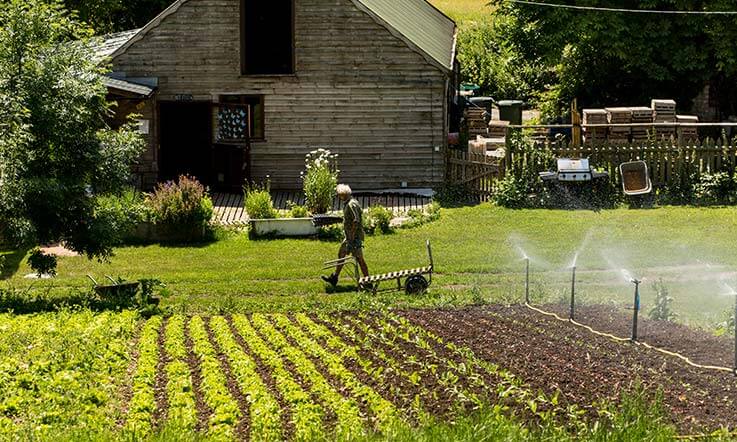Trees and woodland can present new opportunities for upland farmers to increase livestock wellbeing and contribute to the profitability of the farm, a role increasingly recognised. However, there are still many questions about the practicalities of how to successfully integrate trees and woodland into farming systems. This practical one-day workshop hosted by Andrew and Shona Barbour of Mains of Fincastle Farm explored the pros and cons of integrating trees, woodland and livestock in upland farming systems, the potential benefits of trees for livestock and for upland farming in general. The day started with presentations covering the influence of trees on animal behaviour, the practicalities and economics of combining grazing animals with trees and grants and support available. Andrew then led us on a farm walk including a visit to his new wood pasture planting designed for stock grazing and shelter throughout the season.
Lindsay Whistance, a livestock researcher at the Organic Research Centre, set the scene by giving a fascinating overview of the interactions between trees and animals, and how and why these interactions can be beneficial to livestock of all types. She included observations of animals using trees for shade and shelter but also for instinctive behaviours such as coat care, nesting and protection for newly born young, browse and dietary enhancement as well as play. She outlined the role of trees as a potential fodder source with evidence of animals offered a variety of browse selecting species such as willow with beneficial or medicinal properties.
Stewart Hendry from Forestry Enterprise Scotland then talked about his experience managing cattle at Loch Katrine as part of the Great Trossachs Forest, an ambitious native woodland partnership project to create 1,900 ha of native woodland through a combination of new planting and natural regeneration. Cattle grazing was introduced to improve the sward diversity in open habitats and woodland understorey, as well as to sustain & rejuvenate old wood pasture and help create new wood pasture. Stewart emphasised that although the site priority was woodland creation the cattle enterprise needed to stack up financially. Highland cattle were chosen and a grazing plan for the site developed. Stewart presented some interesting data on calf and cow weights demonstrating the value of shelter, especially the cow weight at weaning, which was consistently higher where shelter from the trees was available.
Mike Strachan from Forestry Commission Scotland gave an update on the current policy and grant situation. The Scottish Government wants to increase tree planting to 15,000 ha per year; in order to reach this goal they recognise that trees and agriculture need to be better integrated. The agroforestry grant available is currently only for sheep grazing but this may change to include cattle. However woodland grazing grants of £100/ ha are also available (with an approved grazing plan) and other support available includes wood pasture creation, woodlands for water if you are in a target catchment as well as a new ‘sheep and trees’ grant. The message here was that if you would like to plant trees on your farm or use existing areas of woodland for grazing, speak to an advisor as there may be support available for your plans.
After the presentations a short workshop introduced the new UK Agroforestry Network and the trees and livestock group. Workshop participants were asked to help us decide on the focus of the group and to think about:
We will be focusing future workshops and the activity of the trees and livestock group around these areas. If you are interested in being part of the group please get touch with Sally Westaway or you can sign up to become part of the wider network.
After a hearty lunch we headed out on farm tour. The farm is 560 ha organic mixed livestock with approximately 60 ha of farm woodlands. Starting at the top of the farm at 400m we looked at the shelterbelt that was planted by Andrew’s uncle and that now offers shelter to half of his flock of sheep. This shelter provision has had a direct and measurable economic impact on the farm they have been able to switch sheep breed to a less hardy but more productive breed and made the business more profitable. The shelter belt is banana shaped which Andrew thinks maximises the shelter provision and the sheep often hide inside it in inclement weather, which has the additional advantage of making them easy to find! They would eventually like to plant another shelter belt on the other side of the hill but this is a protected area and they need permission from SNH to put trees here. Down the hill we were shown a small copse beside the track where an area of trees acts as the farm maternity unit with cows choosing to use the shelter and privacy that the trees provide to calve in. Kate Holl from SNH gave a brief summary of the woodland grazing toolbox which is due to be updated at the end of 2017, and the possibility of adapting it for England to encourage active management of small unmanaged on-farm woodlands was also discussed. Then we continued down to have a look at some newer tree planting, with mixed native species wooded strips. Some trees here are being side pruned with a timber crop in mind, the silver birch and the wild cherry, in particular, can give a high value crop if sold into craft market. The intention is also to manage some as coppice and to eventually allow the stock access to graze/shelter throughout.
